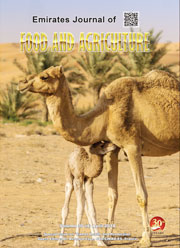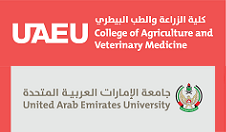Dromedary camel health care practices reported by caretakers working at a permanent market
DOI:
https://doi.org/10.9755/ejfa.2021.v33.i4.2688Abstract
Traditional health care practices and ethnoveterinary medicine are still common in camels. This study aimed at describing camel health issues reported by caretakers including their management and treatment practices. Associations between the health issues and caretakers’ background, management practices, and facilities were also investigated. Camel caretakers (n=49) at a permanent market in Qatar were interviewed and data related to the camel pens (e.g. presence of shelters, water, and feeding points) collected. During the interview, questions sought to elicit the following information; i) caretaker’s background (age, level of education, experience, and how they identify when a camel is sick), ii) caretaker’s management practices (feeding, watering, and health care practices), iii) caretaker’s description of the last health problem (camel details, recalled diagnosis/clinical signs, possible cause, treatment, and outcome). The majority of the caretakers were middle-aged (31-50 years old) and they used to identify a sick camel mainly observing its behavioural modifications (p < 0.001). Treatment for endo- and ectoparasites were usually administered by caretakers, health checks routinely performed by veterinarians, while vaccinations were not conducted in most of the pens (p < 0.001). A total of 38 health problems were described and the high environmental temperature was the most reported possible cause (43.2%; p < 0.001). Among the recalled health problems, sunstrokes were the most common (11/38; p = 0.046), followed by fever (9/38). Sunstroke was more likely to affect males (OR: 5.04; CI95%: 1.87-23.38; p = 0.039), while fever younger animals (OR: 0.68, CI95%: 0.47-1.00; p = 0.050). Sunstrokes were more likely managed by non-veterinarians (OR: 4.75; CI95%: 1.05-21.34; p = 0.042). The majority of the cases were early identified and had a full recovery, but 11/38 camels died. Interestingly, drugs were the most common treatment (73.7%, p < 0.001), but often bought and administered directly by caretakers. Duty of care, infectious disease prevention, early and appropriate treatments could be recommended to guarantee the principle of good health and consequently animal welfare. Education on how to identify a sick camel and how to manage it should be also promoted.
Downloads
References
Abdallah, H.R. and Faye, B., 2013. Typology of camel farming system in Saudi Arabia. Emirates J. Food Agric. 25: 250–260.
Abera, M., O. Abdi, F. Abunna and B. Megersa. 2010. Udder health problems and major bacterial causes of camel mastitis in Jijiga, Eastern Ethiopia: implication for impacting food security. Trop Anim Health Prod. 42(3): 341-7.
Agab, H. 2006. Diseases and causes of mortality in a camel (Camelus dromedarius) dairy farm in Saudi Arabia. J. Camel Pract. Res. 13: 165–169.
Agab, H. and B. Abbas. 1999. Epidemiological studies on camel diseases in eastern Sudan. World Anim. Rev. 92: 42–51.
Ahmed Kamal, S. 2011. Observations on rift valley fever virus and vaccines in Egypt. Virol. J. 8: 532.
Al-Ahmadi, K., M. Alahmadi and A. Al-Zahrani. 2020. Spatial association between primary Middle East respiratory syndrome coronavirus infection and exposure to dromedary camels in Saudi Arabia. Zoonoses Public Health 67: 382–390.
Ali, B.H. 1988. A survey of some drugs commonly used in the camel. Vet. Res. Commun. 12: 67–75.
Altman, D.G. 2014. Categorizing Continuous Variables. Wiley StatsRef Stat. Ref. Online 1–5.
Aubè, L., M. Fatnassi, D. Monaco, T. Khorchani, G.M. Lacalandra, M. Hammadi and B. Padalino. 2017. Daily rhythms of behavioral and hormonal patterns in male dromedary camels housed in boxes. PeerJ. 5: e3074.
Averós, X., L. Brossard, J.Y. Dourmad, K.H. de Greef, H.L. Edge, S.A. Edwards and M.C. Meunier-Salaün. 2010. A meta-analysis of the combined effect of housing and environmental enrichment characteristics on the behaviour and performance of pigs. Appl. Anim. Behav. Sci. 127: 73–85.
Aziz, M.A., A.H. Khan, and A. Pieroni. 2020. Ethnoveterinary plants of Pakistan: a review. J. Ethnobiol. Ethnomed. 16: 25(2020).
Basheir, B.O., K.H. ElMalik, A.E. Abdelgadir, and A.A.R. Gameel. 2012. Traditional and modern practices in the diagnosis, treatment and prevention of animal diseases in South Kordofan State, Sudan. J. Cell Anim. Biol. 6: 213–225.
Bengoumi, M. and B. Faye. 2002. Adaptation du dromadaire à la déshydratation. Sécheresse (Montrouge) 13: 121–129.
Bouâouda, H., M.R. Achâaban, M. Ouassat, M. Oukassou, M. Piro, E. Challet, K. El Allali and P. Pévet. 2014. Daily regulation of body temperature rhythm in the camel (Camelus dromedarius) exposed to experimental desert conditions. Physiol. Rep. 2(9): e12151.
Christley, R.M. 2016. Questionnaire survey response rates in equine research. Equine Vet. J. 48: 138–139.
Cohen, N.D., M.S. O’Conor, M.K. Chaffin and R.J. Martens. 2005. Farm characteristics and management practices associated with development of Rhodococcus equi pneumonia in foals. J. Am. Vet. Med. Assoc. 226: 404–413.
Dean, R.S. 2015. The use and abuse of questionnaires in veterinary medicine. Equine Vet. J. 47: 379–380.
Dereje, M. and P. Udén. 2005. The browsing dromedary camel: I. Behaviour, plant preference and quality of forage selected. Anim. Feed Sci. Technol. 121: 297–308.
EFSA. 2010. Animal welfare risk assessment guidelines on housing and management (EFSA Housing Risk). EFSA Support. Publ. 7.
El-Shoukary, R.D., N. Nasreldin, A.S. Osman, N.M. Hashem, I.M. Saadeldin and A.A. Swelum. 2020. Housing management of male dromedaries during the rut season: Effects of social contact between males and movement control on sexual behavior, blood metabolites and hormonal balance. Animals 10: 1–11.
El Harrak, M. 2014. Priority Diseases of Camelids. Retrieved on September 07, 2020 from: https://www.oie.int/eng/refcentre2014/pdf/Presentations/S6_Parallel_Sessions/PS_Camelids_1_DrElharrak_2014.pdf
El Harrak, M., B. Faye and M. Bengoumi. 2011. Main pathologies of camels, breeding of camels, constraints, benefits and perspectives, in: Recommendation No. 2 - 19th Conference of the OIE Regional Commission for Africa. (pp. 1–6). Kigali, Rwanda.
El Shoukary, R.D., A. Osman and A. Mohammed. 2020. Effects of Stocking Density on Some Behavioral and Some Blood Biochemical Parameters in Camel during the Rut Period. Egypt. J. Vet. Sci. 51: 253–262.
Fatnassi, M., B. Padalino, D. Monaco, L. Aubé, T. Khorchani, G.M. Lacalandra and M. Hammadi. 2014a. Effect of different management systems on rutting behavior and behavioral repertoire of housed Maghrebi male camels (Camelus dromedarius). Trop. Anim. Health Prod. 46: 861–867.
Fatnassi, M., B. Padalino, D. Monaco, T. Khorchani, G.M. Lacalandra, M. Hammadi. 2014b. Evaluation of sexual behavior of housed male camels (Camelus dromedarius) through female parades: correlation with climatic parameters. Trop. Anim. Health Prod. 46: 313-321
Faye, B. 2020. How many large camelids in the world? A synthetic analysis of the world camel demographic changes. Pastoralism 10: 25(2020).
Faye, B. 2014. The Camel Today: Assets and Potentials. Anthropozoologica 49: 167–176.
Galav, P., A. Jain, S.S. Katewa and A. Nag. 2010. Animal healthcare practices by livestock owners at Pushkar animal fair, Rajasthan. Indian J. Tradit. Knowl. 9: 581–584.
Gupta, L., G. Tiwari and R. Garg. 2015. Documentation of Ethnoveterinary remedies of camel diseases in Rajasthan, India. Indian J. Tradit. Knowl. 14: 447–453.
Hemsworth, P.H., J.L. Barnett and G.J. Coleman. 1993. The Human-Animal Relationship in Agriculture and Its Consequences for the Animal. Anim. Welf. 2: 33–51.
Hoffmann, I. 2010. Climate change and the characterization, breeding and conservation of animal genetic resources. Anim. Genet. 41: 32–46.
Hoter, A., S. Rizk and H.Y. Naim. 2019. Cellular and molecular adaptation of Arabian camel to heat stress. Front. Genet. 10: 588.
Ibrahim, W.Y., H.M. Homeida, H.M. Ali, H.J. Hassan, H. Hapke, B.H. Ali and H. Elsheik. 1997. Oxytetracycline bioavailability in camels after LV. and I.M. administration of 5 . 0 mg/kg bdwt. single doses, Annual Report. Sudan.
Khalafalla, A.I. 2017. Emerging infectious diseases in camelids. Emerg. Re-emerging Infect. Dis. Livest. 425–441.
Khan, B., M. Leteef, M. Bilal, A. Iqbal and R. Hassan. 1998. A study on some of the activity patterns of Camelus dromedarius maintained in Thal area of the Punjab Pakistan. Pakistan J. Agric. Sci. 33: 67–72.
Khan, B.B., A. Iqbal and M. Riaz. 2003. Production and management of camels -Part III, in: Khan, B.B., Iqbal, A., Riaz, M. (Eds.), Production and Management of Camels. Department of Livestock Management University of Agriculture Faisalabad, Faisalabad.
Lamuka, P.O., F.M. Njeruh, G.C. Gitao and K.A. Abey. 2017. Camel health management and pastoralists’ knowledge and information on zoonoses and food safety risks in Isiolo County, Kenya. Pastoralism 7: 20(2017).
Menchetti, L., M. Zappaterra, L. Nanni Costa and B. Padalino. 2021. Application of a protocol to assess camel welfare: scoring system of collected measures, aggregated assessment indices, and criteria to classify a pen. Animals 11: 494.
Menchetti, L., B. Faye and B. Padalino. Under review. New animal-based measures to assess welfare in dromedary camels. Manuscript submitted to Trop. Anim. Health Prod.
Mohammadpour, R., M. Champour, F. Tuteja and E. Mostafavi. 2020. Zoonotic implications of camel diseases in Iran. Vet. Med. Sci. 6: 359–381.
Oukessou, M., J. Hossaini, R. Zine‐Filali and P.L. Toutain. 1990. Comparative benzylpenicillin pharmacokinetics in the dromedary Camelus dromedarius and in sheep. J. Vet. Pharmacol. Ther. 13: 298–303.
Padalino, B., L. Aubé, M. Fatnassi, D. Monaco, T. Khorchani, M. Hammadi and G.M. Lacalandra. 2014. Could dromedary camels develop stereotypy? The first description of stereotypical behaviour in housed male dromedary camels and how it is affected by different management systems. PLoS One 9(2): e89093.
Padalino, B. and L. Menchetti. 2021. The first tool for assessing welfare of camels. Front. Vet. Sci. 7: 631876.
Padalino, B., C.W. Rogers, D. Guiver, K.R. Thompson and C.B. Riley. 2018. A survey-based investigation of human factors associated with transport related injuries in horses. Front. Vet. Sci. 5: 294.
Pastrana, C.I., F.J.N. González, E. Ciani, C.J.B. Capote and J.V.D. Bermejo. 2020. Effect of research impact on emerging camel husbandry, welfare and social-related awareness. Animals 10: 780.
Peduzzi, P., J. Concato, E. Kemper, T.R. Holford and A.R. Feinstein. 1996. A simulation study of the number of events per variable in logistic regression analysis. J. Clin. Epidemiol. 49: 1373–1379.
Perlman, S. and R. Vijay. 2016. Middle East respiratory syndrome vaccines. Int. J. Infect. Dis. 47: 23–28.
Previti, A., B. Guercio and A. Passantino. 2016. Protection of farmed camels (Camelus Dromedarius): Welfare problems and legislative perspective. Anim. Sci. J. 87: 183–189.
Rushen, J. and A.M. de Passillé. 2017. The importance of good stockmanship and its benefits to animals., in: Improving Animal Welfare: A Practical Approach. (pp. 125–138).
Rutagwenda, T. and W. Munyua. 1983. The effects of Panacur (Fenbendazole) on Nematode parasites of camels under nomadic conditions in Northem Kenya. Bull. Anim. Hlth. Prod. Afr. 33: 63–67.
Saadeldin, I.M., A.A.A. Swelum, M. Elsafadi, A. Mahmood, A. Osama, H. Shikshaky, M. Alfayez, A.N. Alowaimer and S. Magdeldin. 2020. Thermotolerance and plasticity of camel somatic cells exposed to acute and chronic heat stress. J. Adv. Res. 22: 105–118.
Schwartz, H.J. and M. Dioli. 1992. The one-humped camel in Eastern Africa, Livestock Production Science. verlag josef margraf Scientific Books, Weikersheim, Germany.
Tilahun, B., M. Bekana, K. Belihu and E. Zewdu. 2013. Camel brucellosis and management practices in Jijiga and Babile districts, Eastern Ethiopia. J. Vet. Med. Anim. Heal. 5: 81–86.
Traoré, B., N. Moula, A. Toure, B. Ouologuem, P. Leroy and N. Antoine-Moussiaux. 2014. Characterisation of camel breeding practices in the Ansongo Region, Mali. Trop. Anim. Health Prod. 46: 1303–1312.
Volpato, G., M.S. Lamin Saleh and A. Nardo. 2015. Ethnoveterinary of Sahrawi pastoralists of Western Sahara: Camel diseases and remedies. J. Ethnobiol. Ethnomed. 11: 54.
Wako, G., M. Tadesse and A. Angassa. 2017. Camel management as an adaptive strategy to climate change by pastoralists in southern Ethiopia. Ecol. Process. 6: 26(2017).
Wosene, A. 1991. Traditional Husbandry Practices and Major Health Problems of Camels in the Ogaden. Nomad. People. 21–30.
Zappaterra, M., L. Menchetti, L. Nanni Costa and B. Padalino. 2021. Do camels (Camelus dromedarius) need shaded areas? A case study of the camel market in Doha. Animals 11: 480.
Zarrin, M., J.L. Riveros, A. Ahmadpour, A.M. de Almeida, G. Konuspayeva, E. Vargas-Bello-Pérez, B. Faye and L.E. Hernández-Castellano. 2020. Camelids: new players in the international animal production context. Trop. Anim. Health Prod. 52: 903–913.










 .
. 